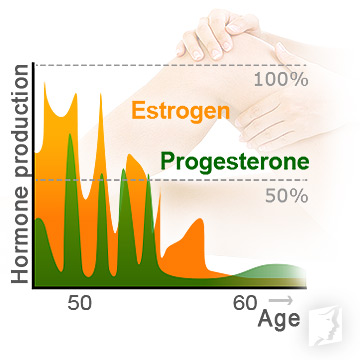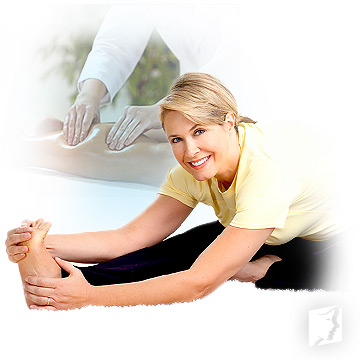Women experience leg cramps at night more often than men, and during the menopausal transition, this can exacerbate or induce other menopause symptoms like insomnia, fatigue, irritability, and mood swings, among others.
Continue reading to learn more about menopause and leg cramps, including why leg cramps during menopause occur, management techniques, and treatment options that will bring you the long-lasting relief you've been searching for.
The Connection between Menopause and Leg Cramps

Little research can be found concerning the link between menopause and leg cramps as the effects of estrogen on skeletal muscles are not well known. Nevertheless, the drastic hormonal fluctuations that ensue during this transitional time are believed to be at fault.
Also, nocturnal leg cramps have been scientifically found to occur more commonly in women, and their prevalence increases with age, further suggesting the role of hormones in the appearance of leg cramps throughout the menopausal transition.
Leg cramps during menopause could also be attributed to the following factors:
- Dehydration
- Muscle fatigue
- Nerve dysfunction
- Electrolyte and mineral imbalances
- Peripheral vascular disease
- Peripheral neuropathy
- Venous insufficiency
- Lumbar canal stenosis
- Cirrhosis
- Medications
- And more
How to Manage Menopause Leg Cramps

No matter the cause, there are some methods that can be used to alleviate leg cramps during perimenopause, including:
Stay hydrated. Drink between six to eight glasses of water a day for optimal hydration since dehydration is a principal cause of muscle cramps at all ages.
Go for a deep tissue massage. Deep tissue massages are often recommended as a therapeutic way of relieving leg cramps during menopause, even though there is limited proof of effectiveness.
Partake in physical therapy. Speaking with a certified physical therapist about leg cramps caused by muscle fatigue will help you find a graded exercise plan for long-term success.
Stretch the calves. Do so by performing a standing wall stretch or by hanging the heels off the corner of a step, letting them dip below the level of your toes.
Exercise mildly before bedtime. Some evidence suggests that a few minutes on a stationary bicycle or a treadmill before bedtime can help keep nocturnal leg cramps during menopause at bay.
Drink some pickle juice. Stimulation of acid-sensing ion channels in the palate and esophagus with pickle juice blocks motor neuron overstimulation that causes muscle cramps.
Consider supplementation. Magnesium, sodium, and B12 vitamins have shown beneficial in helping with leg cramps. Speak with your doctor concerning proper dosing.
How to Treat Menopause Leg Cramps

Treating leg cramps will depend greatly upon the underlying cause. For otherwise healthy women passing through the menopausal transition, hormonal imbalance may be to blame, making this the primary issue needing to be resolved.
Menopause symptom treatments that evolve around promoting endocrine system health are centered on healthy nutrition, regular exercise, and wholesome habits for symptom-relief.
Initially, women should focus on optimizing their diets to include ample amounts of lean protein, complex carbs, and healthy fats that consist of foods rich in plant-based estrogens. These include legumes, nuts, seeds, soy, and fresh fruits and vegetables. When rounded off with regular exercise 30 minutes a day, five days a week and addiction control, women are on their way to hormonal health.
However, for optimal results at beating leg cramps during menopause, women should consider the use of alternative medicine, such as phytoestrogenic herbal supplements or hormone-regulating supplements, both of which directly combat hormonal imbalance.
For women who suffer from leg cramps during perimenopause due to other causes, work with your trusted healthcare provider to find the right solution for you, which could include a medication regimen.
Key Takeaways
Women who are passing through the menopausal transition and suffering from leg cramps should rest assured that they are not alone. Because this symptom is common in women as they pass throughout the years, hormones are believed to be a main underlying cause. However, leg cramps during menopause can also be due to dehydration, medications, muscle fatigue, nerve dysfunction, peripheral neuropathy, and more. While management techniques like stretching the calves, having a deep tissue massage, and mildly exercising before bedtime can allay the cramps short-term, long-term relief is only found once the underlying cause is addressed. If the culprit is hormonal imbalance, women should support endocrine health with an optimized diet and regular exercise as well as addiction control. Treatment for menopause leg cramps attributed to other causes should be talked on a one-to-one basis with your doctor.
Sources
- Allen, R.E. et al. (2012). Nocturnal Leg Cramps. American Family Physician, 86(4), 350-355. Retrieved July 16, 2019, from https://www.aafp.org/afp/2012/0815/p350.html
- Laakkonen, E.K. et al. (2017). Estrogenic regulation of skeletal muscle proteome: a study of premenopausal women and postmenopausal MZ cotwins discordant for hormonal therapy. Aging Cell, 16(6), 1276-1287. doi: 10.1111/acel.12661
- University of Rochester Medical center. (2016). Spice, Pickles for Leg Cramps... Can it be that simple? Retrieved July 16, 2019, from https://www.urmc.rochester.edu/ob-gyn/ur-medicine-menopause-and-womens-health/menopause-blog/november-2016-1/spice-pickles-for-leg-cramps-can-it-be-that-simple.aspx

